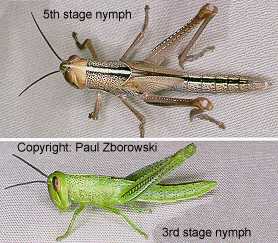Nymph description 2 of 15

Distribution

Nymph Description: Colour is variable. Early instars tend to be green with variations from orange to yellow and straw. Later instars the become grey as they approach the adult stage. Patterns of dark spots in early instars become less distinct in later stages. In profile the body of tends to be held with the head very high. In early instars the line of the top of the body is concave but becomes very straight in later instars. From above, the body is proportionally thinner than other locust nymphs. The oblong eye is vertical in profile and appears larger than it is because a dark thin stripe flows out of it downward. The rear legs are long and visibly thinner than in most other species. No bands on the femur. The slightly crested thorax develops a bright light stripe against a darker patch (like in adults).
Confusion with Australian plague locust: Too big and elongate to be confused.
Confusion with Valanga: Both have a large, long, often colourful body with long black legs (compare photos).
Confusion with Bermius: Young Austracris nymphs are similar in size and colour to older Bermus nymphs but the same size individuals have shorter wing buds and lack the dark body stripe of Bermius (compare photos).
Unique features: The combination of size, elongate and patternless coloured body with thin long black legs, distinguish them from plague locust nymphs. The main difference from Valanga is the generally uniform colour of the body with no bands on the rear femur and the presence of a white stripe on the top of the thorax.
Further information on this species: Description of adult, More images, Distribution, Biology
